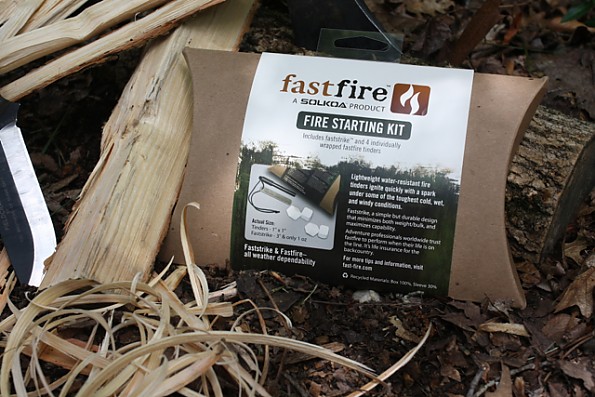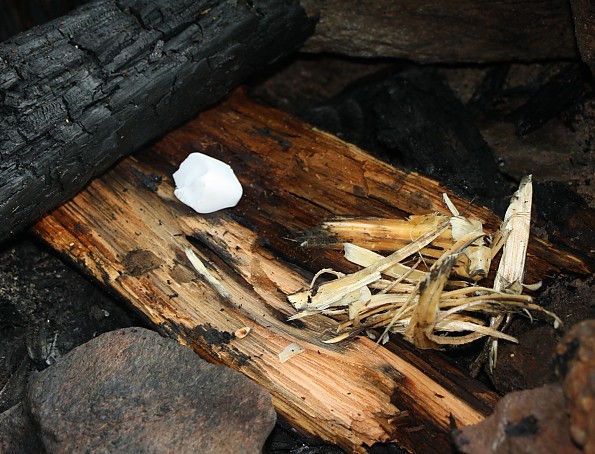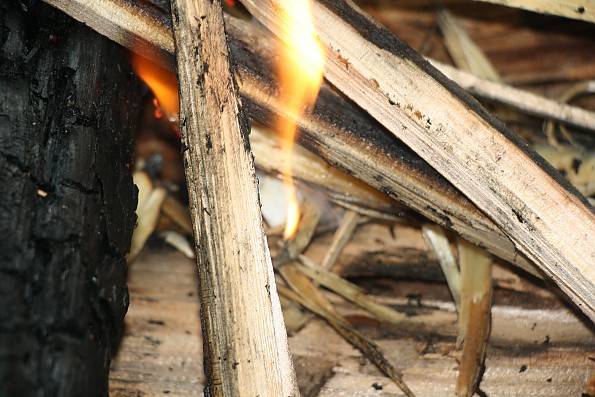SOLKOA Fastfire Fire Starting Kit

A good fire kit for anyone who may need to light a fire—camper, backpacker, hunter, or stranded traveler—especially under adverse conditions. Just familiarize yourself with the limits of the hacksaw striker, which gouges the ferro rod badly and struggles to cast sparks in the rain.
Pros
- Fair price point
- Quick-lighting and long-lasting tinder
- Weather-resistant tinder burns strongly
Cons
- Faststrike hacksaw striker is a potential liability in adverse conditions
SOLKOA Fastfire Fire Starting Kit

Note: The following review is a bit involved; please use the following outline to expedite locating information of interest to you.
I. Product Specifications
II. Testing
III. Faststrike Tests
A. Summary
B. Details
IV. Fastfire Tests
A. Summary
B. Details
V. Video: Severe Thunderstorm Test
VI. Conclusions
I. Product Specifications
The Fire Starting Kit includes one Faststrike (a 3-inch ferrocerium rod with attached 3-inch, hardened steel hacksaw blade) and four Fastfire cubes--SOLKOA’s proprietary tinder material that will--according to their site--produce “a wind resistant flame that will ignite when wet,” burn at 1,300 degrees Fahrenheit, and last “10-12 minutes.”

Here are the full specs from SOLKOA:
Fastfire cubes:
-
Size: 1” x 1”
-
Weight: 0.2 oz.
-
Generates a sustained flame up to 1300°F
-
Water resistant. Burns even when wet
-
Wind resistant.
-
Smokeless and odorless
-
Ignites easily from any spark or any flame
-
Low flashpoint of 140°F
-
Individually packaged in heavy-duty foil laminate for long shelf-life and durability.
-
Left whole, one cube will burn vigorously for 10 – 12 minutes
-
Divided into eight piece each piece will burn 2 – 3 minutes
-
Once extinguished, Fastfire material cools to the touch within seconds
Faststrike:
-
Size: Rod – 3 ½” long, ¼” dia. Hacksaw Blade Striker 3” x ½”
-
Weight: 1 oz.
-
Rod and blade attached by 17” Type I nylon cord
-
Good for 5,000 strikes
-
Rod includes rubber grip
Note: SOLKOA’s listed weights evidently do not take into consideration the striker and lanyard of the Faststrike and the packaging of the Fastfire: my own measurements found that the ferrocerium, hacksaw striker, and lanyard weighed 1.1 oz./31g, while an individual Fastfire cube in its packaging weighed .38 oz./11g.
What I immediately liked about these specs was the attention to detail: I’m not sure I will ever need to know that the lanyard that attached the ferrocerium rod to the hacksaw blade is Type I nylon cord (evidently this has a breaking strength of 95 lbs.), but there is something reassuring about possessing a survival tool that comes from a detail-oriented company. The ability to extend use by dividing the Fastfire cubes, the inclusion of a striker that has multiple uses--these are details that suggest a careful approach to product design and development.
The directions on the packaging bear out this suggestion. After a preliminary statement discouraging the use of Fastfire as a solid cooking fuel, the directions include a paragraph on “Fire Preparation & Building.” The suggestions are solid ones: create a base for your fuel to insulate it from the ground, prop up kindling to ensure good air flow. The fire starting directions reveal that the Fastfire product is potent. Each block “can easily be divided into eighths,” the packaging indicates, and a fraction of a cube is all that is needed under optimal conditions; additional pieces can be added to ignite “materials that are excessively cold or damp.”
An additional note in the box reminds users of the coating on the ferrocerium rod, recommending that this be scraped off with the teeth of the provided hacksaw blade.
II. Testing
Tests of this product and its component parts were conducted both at my house under controlled conditions and during a severe thunderstorm, and also conducted daily during a four-day backcountry trek in the Linville Gorge Wilderness of North Carolina. Tests were conducted in weather ranging from calm and sunny conditions to severe thunderstorm conditions. General conditions during the backcountry trek varied from heavy downpours to bright sun in usually humid conditions ranging from the upper 60’s to the lower 80’s (Fahrenheit). Test sites in the backcountry were located at elevations of 2846 ft., 2771 ft., and 3213 ft; my home is situated at an elevation of 915 ft.
III. Faststrike Tests
A. Summary
The Faststrike was tested in component parts, as both a ferrocerium rod used to ignite various tinders and as a hacksaw blade for cutting. Faststrike is a serviceable ferrocerium rod that comes with lightweight hacksaw striker, but with the weight savings comes liability--other strikers I have used allow more controlled direction of sparks and less aggressive gouging of the rod’s material. Though adequate to ignite both natural tinders and the Fastfire tinder in dry or humid conditions, the Faststrike struggled significantly to throw sparks under severe thunderstorm conditions. The hacksaw blade performed well as a saw, though obviously its short length is a limitation that requires a greater expenditure of energy than a longer blade would require.
B. Details
I began my exploration of the Faststrike with an examination and testing of the striker, the hardened steel hacksaw blade attached by Type I nylon cord to the ferrocerium rod itself. At 3 inches, the blade is lightweight, and the teeth proved plenty sharp. I grabbed a segment of an old trekking pole and sawed away with the blade to gauge its ability as a hacksaw. While the short length created inefficient, short strokes, the blade cut into the pole with no problem. SOLKOA notes one use is to create fine scrapings for tinder; it easily accomplishes this. I then proceeded to use the blade in conjunction with the ferrocerium rod itself.
The 3-inch rod is a nice sizea smaller rod complicates gripping the tool, while larger rods add weight and grow increasingly unwieldy for backpackers. Following the provided directions, I used the toothed edge of the hacksaw to scrape off the black coating on the ferrocerium rod. After a few scrapes, the teeth threw sparks. I quickly discovered that the back edge of the blade could not throw sparks—it was too rounded off to remove any material from the rod.
A quick check of the SOLKOA site showed the Faststrike’s big brother, the Faststrike Maxx, being used with the teeth on the rod, so I returned to this mode of use. Yes, sparks were produced without a problem, but the jagged angles of the hacksaw teeth threw them in many different directions, and the teeth themselves gouged deeply into the rod.
Experimenting in dry conditions with wood shavings and birch bark as tinders, I found the sparks difficult to direct. A shower was produced, but it resembled more the radiant shower of a sparkler than the directional spray I sought. I had to work a bit to get my dry natural tinders to ignite. To further test the Faststrike, I used the back of my Opinel No. 7 pocket knife with the Faststrike as an alternate striker, producing an abundant spray of sparks that suggested that the hacksaw striker was the limiting factor, not the Faststrike rod itself. Unlike the hacksaw blade, the knife also allowed me to control the direction of the sparks more efficiently, too, an obvious benefit in terms of fire-starting.
To me, then, the scattered sparks of the hacksaw striker were problematic: while the blade provides a lightweight, multipurpose option, it is not as efficient as other strikers that I have used (notably the Exotac Polystriker XL’s superb striker). In this instance, the multipurpose and lightweight aspects of the striker seem diminished by its reduced functionality as a striker. It usually worked, but I found I preferred other options.
This hit-or-miss sparking became a liability when I attempted to use the Fastrike during a severe thunderstorm (see part V, below). The rain was heavy, coating the rod, and I struggled to get any sparks at all from the Faststrike--the few that were produced could not ignite the Fastfire. For a comparison, the Exotac Polystriker XL achieved more favorable results during the same storm. To be fair, the Exotac may have been slightly drier than the Faststrike and it also benefits from a well-designed striker; had it been just as wet in that same moment, perhaps it would have struggled, too.
Other testing, though, revealed that the Exotac easily outperformed the Faststrike/hacksaw striker combination in dry conditions, too, throwing more focused, longer lasting sparks. To be thorough, I tested the Faststrike again when the rain later slackened and did experience greater luck in throwing sparks with it. It was overall more quirky than consistent.
While most people don’t attempt to light fires in severe thunderstorms, this experience is certainly food for thought and a reminder to practice with your kit before relying on it in the field. Bottom line: If I were relying on the Faststrike for long-term fire building, I would opt for an alternate striker.
IV. Fastfire Tests
The Fastfire tinder worked well under all weather conditions, including wind and rain--sustainable fires were ignited each time Fastfire was used, whether it was employed whole or as a half, a quarter, or an eighth of a cube. The Fastfire tinder ignited easily by spark or flame when the manufacturer’s directions were followed. The manufacturer’s claims on burn times seem consistent with testing.
B. Details
The Fastfire tinder comes in a relatively heavy foil pouch that offers the tinder good protection from the elements. The tinder material itself appears to be hydrophobic, and it easily divides into halves and quarters and eighths with a slice of a knife. I tested the Fastfire on successive nights and some mornings of my backpacking trip with the weather conveniently offering a wide range of atmospheric conditions. Afternoon rains preceded my arrival in camp on the first night, but I was able to easily ignite the damp kindling using half of a Fastfire cube. The mountains were determined to give me a challenge, though, and within half an hour a torrential downpour began that completely extinguished the once-healthy and hearty fire.
The following morning I split some kindling to access the dry core and tried to start a fire again using the Fastfire. Despite a sodden firepit (lined with damp logs) and marginal natural tinder and kindling, the Fastfire tinder did the trick again, earning my healthy respect. I soon had a blaze that dried my clothes.



Subsequent tests of the Fastfire were under increasingly favorable conditions: the rain cleared out, and while the humidity remained, the wilderness was gradually drying out and making fire-building an increasingly easy task. The Fastfire made it seem almost effortless.
While I did use the Faststrike to ignite the Fastfire, I also tested it with matches and a lighter—brilliant results! The Fastfire inspired confidence, especially when I gratuitously placed an entire cube in the fire pit. You really can get by with fractions of a cube if you prepare your wood in advance, just as one should when building any fire. Had I had more samples, I probably would have worked out the amount needed to a more exact science. This is a product that is gratifying to use!
So what about the really nasty weather? Well, I decided to chance that at home and not risk exposing myself to lightning on top of a mountain in the backcountry. When my weather radio indicated a severe thunderstorm was coming with gusts of up to 58 mph, I headed outside to test the kit. I prepped for this test by shaving curls of wood off a stick and by keeping a stack of kindling on hand. All materials, however, were soaked before I began the test.
Following the manufacturer’s directions, I began with a quarter cube and attempted to shave some filings off to give the Faststrike more surface area on which to throw sparks. The hacksaw blade worked well for the shavings, but the rain and wind were such that the dust was instantly immersed in a puddle, and this technique did not work. Over the course of fifteen minutes I tried different ignition sources when I discovered the Faststrike was not working: a match seemed only to dry the water off the outside of the cube (it was still raining, so this was a challenge), but the longer-lasting flame of a lighter did manage to ignite the Fastfire tinder in these wretched conditions.
Despite the wind and rain, it remained burning, too (I did smother a piece once, but that was due to my own carelessness, not environmental conditions). I was elated and impressed. I subsequently used my Exotac Polystriker XL with fragments of the Fastfire, and it ignited them with just a spark. The eventual fire that burned in spite of the lingering drizzle stood testament to the ability of this remarkable tinder to triumph even in the face of really awful weather.
V. Video
Below is a short video that shows portions of the severe thunderstorm test to which I have alluded previously. If you watch this video via YouTube, a link in the video description will take you to a longer cut of this video (15 minutes) that chronicles this daunting experience and its eventual success in more detail, showing also my experiments with a knife and another ferrocerium rod to help me gain a frame of reference for understanding this kit’s performance under these conditions. Sorry about the poor video quality: I had to use an older waterproof camera.
VI. Conclusions

At $19.95, the SOLKOA Fastfire Fire Starting Kit is a good value that takes some of the anxiety out of fire-building, allowing one to sit back and enjoy a fire. Some popular ferro rods cost as much as this kit, but with this kit one gets not only a rod but also four excellent tinders.
I have expressed reservations about the hacksaw striker: I like its weight and multipurpose utility, but I think there are better options to use. When I needed it to work in the rain, it didn’t. That said, the Faststrike itself is perfectly serviceable and well-sized.
The Fastfire tinders themselves are highly recommended. Yes, there are many natural or homemade tinders or firestarters that work just fine, like the venerable cotton ball rubbed with petroleum jelly.However, I plan to keep some Fastfires as part of my permanent kit for emergency use, for those situations and conditions when I need a sure thing with a known burn time.
If you already have a ferrocerium rod but are intrigued by the Fastfire tinder, consider SOLKOA’s Fastfire Refill Pack ($13.95 online) of eight individually wrapped Fastfire tinders. If you opt for the full kit, make sure you are comfortable with the hacksaw striker under all sorts of conditions before having to rely on it.
Source: received for testing via the Trailspace Review Corps
(Sample provided by Solkoa for testing and review)







